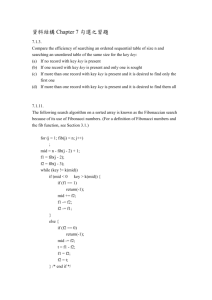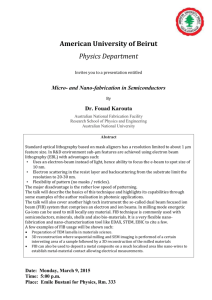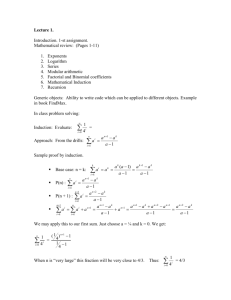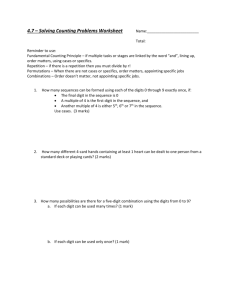paper
advertisement
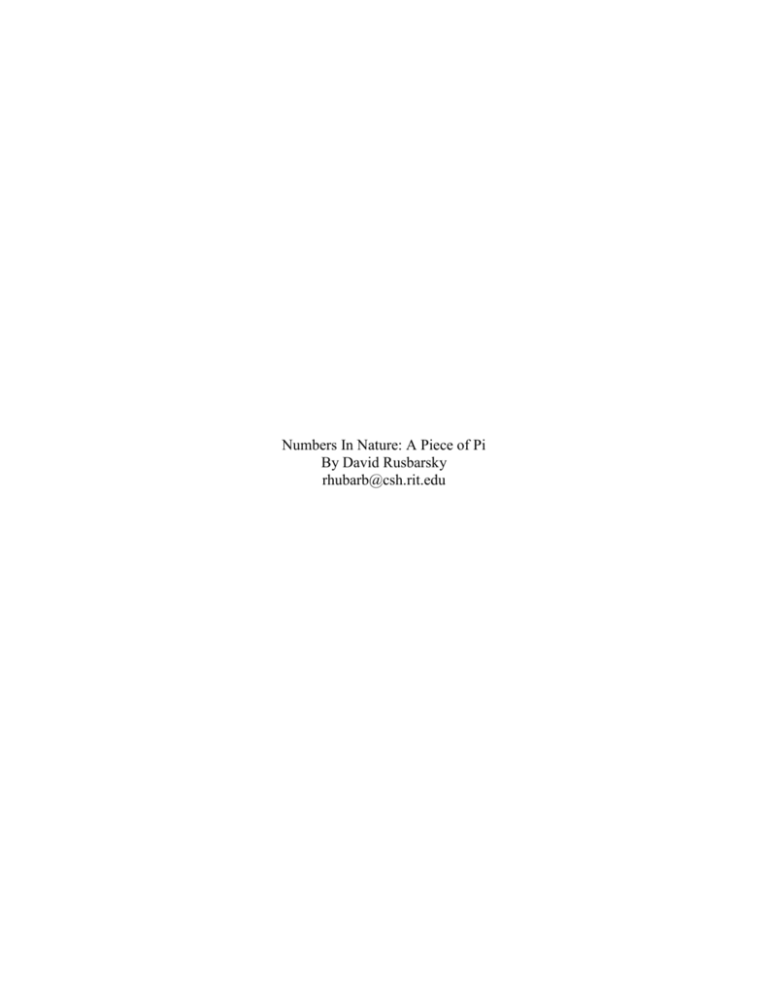
Numbers In Nature: A Piece of Pi By David Rusbarsky rhubarb@csh.rit.edu Throughout time numbers and their seemingly magical properties have fascinated many people. Probably the most popular of these would be the number Pi. With its seemingly endless trail of decimal points we can sometimes imagine that a pattern must exist to explain the chaos. If there were a pattern, what would happen? What would that mean? These questions can probably not be answered until a pattern is found and the repercussions are already set in motion. To help us understand pi, let us take a step back from the number and look at where in the real world we find this number. We can find it all over in nature. In circles, spheres, spirals, etc. What else can we find in nature? The Fibonacci numbers can be found all over in nature as well. Could it be that these two numbers are somehow related? Would it make sense to find out that there is a relationship between two numbers that are commonly found in nature? Let us venture back to the number to take a closer look. Let us assume that the Fibonacci numbers will be grouped into sets of two. This means that 1 and 1 will be a set, 2 and 3 will be a set, and so forth. If we were to look for these sets in the digits of pi, spacing each of the numbers in the set evenly, we will eventually find these the digits we are looking for, provided the digits of pi have even distributions (ie, there is no pattern to the digits). This can be seen when we search for the set 1,1 in Pi. We find the first 1 in the second digit of pi (ignoring the decimal). The second 1 could then be found by jumping the same number of spaces (2). 314159… Finding the second set (2,3), we can see that the jump size is 3: 31415926535897… Finding the third set (5,8), we can see that the jump size is 1: 31415926535897… The average jump should approach 100. This is because while we are searching through all the possible jumps, there is a 1 in 10 chance of finding the number we are looking for and a 1 in 10 chance of the number of spaces we have jumped so far will result in the second number we are looking for. 1/10 * 1/10 = 1/100. As you can see, we are off to a good start finding the first three sets in well under what the average should be. This obviously shouldn’t mean much because we don’t know what the next jump will be, but it makes our jobs of finding the sets a whole lot easier when they appear well below this expected average jump size. If we continue to go at this rate, we run into a problem when the Fibonacci numbers start to increase past 8. Searching for single digit numbers in a single digit number set is fine, but now we want to search for a multiple digit number in a single digit number set. Using a technique I call folding (I believe the proper terms are Additive Persistence [http://mathworld.wolfram.com/AdditivePersistence.html] and Digital Root[http://mathworld.wolfram.com/DigitalRoot.html], although the process is slightly modified to allow for 0s), we can condense any number into a single digit. Adding all the digits of a number together to produce a new number does this. If that number is then a multiple digit number, we can perform the process again and again until a single digit results. One side note I should mention is that if a number is a multiple of 10 at the end of any of the foldings, it is then converted to a zero so that zeros could be represented in our number set. Since the next set we are looking for includes multiple digit numbers, lets take a look at that as an example: The next Fibonacci number is 5+8=13 Following our process, 13 1+3=4 4 is a single digit, so we can stop. The next Fibonacci number is 8+13=21 Following our process, 21 2+1=3 3 is a single digit, so we can stop. Therefore, the next set we are looking for is 4,3. I will refer to the number of times you must do this process as the degree of folding. Both of these numbers only required one run though the process, so they would only have a folding degree of 1. There might be more rules to this process, but this gives you the basic ides of how we will be searching for the Fibonacci numbers in Pi. The other rules are still being looked at and being considered before I write about them. Oh, and incase you were wondering, our new set can be found with a jump size of 8. In fact, here is a look at the first 46 Fibonacci numbers in 23 sets including at what locations the numbers are found in Pi. The Rn numbers are what I refer to as Rhubarb numbers and they represent the jump size for that pair. R0: 2 Fib pair (1,1) at 2,4 R1: 3 Fib pair (2,3) at 7,10 R2: 1 Fib pair (5,8) at 11,12 R3: 8 Fib pair (4,3) at 20,28 R4: 29 Fib pair (7,0) at 57,86 R5: 22 Fib pair (8,9) at 108,130 R6: 21 Fib pair (8,8) at 151,172 R7: 5 Fib pair (0,6) at 177,182 R8: 7 Fib pair (4,0) at 189,196 R9: 57 Fib pair (5,6) at 253,310 R10: 184 Fib pair (0,8) at 494,678 R11: 43 Fib pair (0,9) at 721,764 R12: 146 Fib pair (0,0) at 910,1056 R13: 55 Fib pair (2,3) at 1111,1166 R14: 4 Fib pair (5,0) at 1170,1174 R15: 1 Fib pair (4,0) at 1175,1176 R16: 582 Fib pair (7,0) at 1758,2340 R17: 49 Fib pair (8,9) at 2389,2438 R18: 111 Fib pair (8,8) at 2549,2660 R19: 2 Fib pair (7,6) at 2662,2664 R20: 1 Fib pair (4,0) at 2665,2666 R21: 9 Fib pair (5,6) at 2675,2684 R22: 98 Fib pair (0,8) at 2782,2880 I found it interesting that the average of these numbers is actually close to 63 and not 100 and only 4 of Rhubarb numbers were over 100, but as I said before, this is inconsequential unless we know all the sets, which is impossible due to the idea that the digits of pi do not end. If we could find a pattern or equation to the Rhubarb numbers, would this then mean there is a pattern to pi? Another interesting development of these numbers is that the Lucas numbers seem to start appearing in a slightly different pattern. The Lucas numbers are derived in the same manner as the Fibonacci numbers, but the first two numbers are 2 and 1 producing the following numbers: 2,1,3,4,7,11,18,… 2 is located at location 1 of our number set, or by jumping 1. The next Lucas number can be found by jumping 2, then 4, then 8 (double the jump for each number) using our previous trick of finding multiple digit numbers in a single digit set. 2,3,1,8,29,22,21,5,7,57,184,43,146,55,4,1,582,49,111,2,1,9,98,… The digits of pi are actually determined by a formula. This formula, however, has changed through the years to get more precise digits. Could the Rhubarb numbers also be expressed with an equation that might change over time to get more precise digits? When the equation for Pi changes, would the equation for the Rhubarb numbers not change as well? Could any of these Rhubarb number be incorrect due to coincidence? Maybe one of those 1 in 100 chances of finding the two numbers we were looking for occurred and we were knocked off the correct path when we were supposed to look a little farther down the chain of Pi digits. Another interesting note to make is the appearance of Pascal’s Triangle in the Fibonacci number sequence. These are two number sets that are commonly found in nature and in the world around us, and they are related. Are we surprised by this? Why should we be surprised to find the Fibonacci numbers in pi then? What does all this mean? Are we stuck in some sort of mad loop looking for patterns in patterns until we come full circle (if we ever come full circle), or are we finding some sort of intricate connections between numbers that are commonly found in nature through the use of mathematics? I would like to think that the latter is true.


